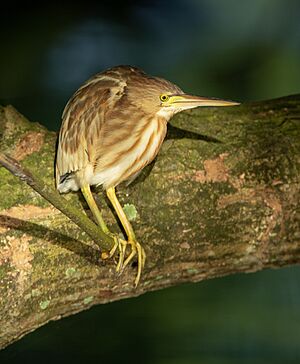Yellow bittern facts for kids
Quick facts for kids Yellow bittern |
|
|---|---|
 |
|
| Conservation status | |
| Scientific classification | |
| Genus: |
Ixobrychus
|
| Species: |
sinensis
|
The yellow bittern (Ixobrychus sinensis) is a small bird. It is a type of bittern, which is a bird related to herons. These birds come from the Old World, meaning Europe, Asia, and Africa. They breed in northern India, stretching east to the Russian Far East, Japan, and Indonesia.
Most yellow bitterns stay in one place all year. However, some birds from colder northern areas travel short distances. This bird has been seen by chance in Alaska. There was also one sighting in Great Britain in 1962. But experts are not sure if that bird flew there naturally.
Contents
About the Yellow Bittern
The yellow bittern is a small bird. It is about 36 to 38 centimeters (about 14 to 15 inches) long. It has a short neck and a long beak. Its legs are yellow-green, and its beak is ivory-colored, with a darker top part. It has a short black tail and yellow eyes.
What Yellow Bitterns Look Like
Male yellow bitterns have a dark cap on their head. Their head and neck are chestnut brown. Their body is a dull yellow color on top and buff (light yellowish-brown) underneath.
Female yellow bitterns look a bit different. Their cap, neck, and chest have streaks. Their upper back and the back of their neck are reddish-brown. Their underparts are streaked with dark red-brown and buff.
Young yellow bitterns look like the females. But their streaks are bolder. Their head and back are brown, and they have buff patches on top.
Where Yellow Bitterns Live
Yellow bitterns live in freshwater marshes and swamps. They like places with lots of reeds and plants near water.
Yellow Bittern Homes
These birds build their nests on small platforms. They use reeds or twigs. They place their nests in thick plants, like reed beds. Sometimes, they build nests in trees or bushes right next to or over the water. Female yellow bitterns usually lay four to six eggs. The eggs are a pale blue-green color.
What Yellow Bitterns Eat
Yellow bitterns are hunters. They eat many different kinds of small animals. Their diet includes insects, fish, and amphibians like frogs. They also eat crustaceans such as crabs, and molluscs like snails.
Protecting the Yellow Bittern
The yellow bittern is a protected bird. It is covered by the Migratory Bird Treaty Act of 1918. This law helps protect birds that fly between different countries.
Images for kids



